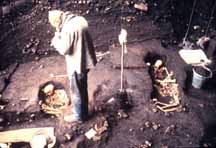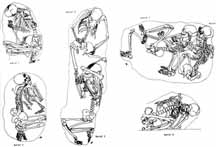burials
 Burials often include excellent information about social status, both for prehistoric societies and today. Those who died in a position of power, be it religious, economic, or political are treated differently than a person of lower status at the time of burial. Today that might translate into differences in the size of a tombstone or the quality of the coffin. In ancient times burials could be differentiated by things like size or the number of textiles and other accompaniments buried with the deceased.
Burials often include excellent information about social status, both for prehistoric societies and today. Those who died in a position of power, be it religious, economic, or political are treated differently than a person of lower status at the time of burial. Today that might translate into differences in the size of a tombstone or the quality of the coffin. In ancient times burials could be differentiated by things like size or the number of textiles and other accompaniments buried with the deceased.
 Societies with more separation between people of higher and lower status usually show a significant differences in how ornate burials were. More egalitarian societies usually show similar burial for all its members. The latter is the case of the preceramic people of the highland Andes.
Excavations
have uncovered many well preserved burials of individuals and sometimes paired individuals. For the most part, there is little buried with these people that has preserved to the present day.
Societies with more separation between people of higher and lower status usually show a significant differences in how ornate burials were. More egalitarian societies usually show similar burial for all its members. The latter is the case of the preceramic people of the highland Andes.
Excavations
have uncovered many well preserved burials of individuals and sometimes paired individuals. For the most part, there is little buried with these people that has preserved to the present day.
 In the Andean highlands, the burials are usually individual and seem to focus on disposing the body in a somewhat orderly and practical manner. Most of the burials uncovered show people on their sides with their knees folded. In the damp soil of the puna caves only whitish silica or calcite 'ghosts' of leather or fiber garments and wrappings can be observed. Even the small quantity of
tools
or other occasional offerings such as grinding stones do indicate some sort of spiritual belief about the dead and their need or use for practical items. The burials shown here were excavated from Panaulauca Cave in Junin and are rather typical of what to expect from a preceramic grave.
In the Andean highlands, the burials are usually individual and seem to focus on disposing the body in a somewhat orderly and practical manner. Most of the burials uncovered show people on their sides with their knees folded. In the damp soil of the puna caves only whitish silica or calcite 'ghosts' of leather or fiber garments and wrappings can be observed. Even the small quantity of
tools
or other occasional offerings such as grinding stones do indicate some sort of spiritual belief about the dead and their need or use for practical items. The burials shown here were excavated from Panaulauca Cave in Junin and are rather typical of what to expect from a preceramic grave.
|
 Burials often include excellent information about social status, both for prehistoric societies and today. Those who died in a position of power, be it religious, economic, or political are treated differently than a person of lower status at the time of burial. Today that might translate into differences in the size of a tombstone or the quality of the coffin. In ancient times burials could be differentiated by things like size or the number of textiles and other accompaniments buried with the deceased.
Burials often include excellent information about social status, both for prehistoric societies and today. Those who died in a position of power, be it religious, economic, or political are treated differently than a person of lower status at the time of burial. Today that might translate into differences in the size of a tombstone or the quality of the coffin. In ancient times burials could be differentiated by things like size or the number of textiles and other accompaniments buried with the deceased.


